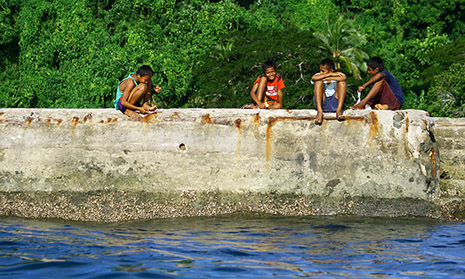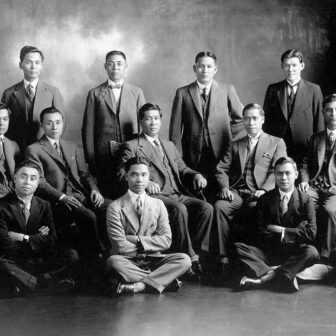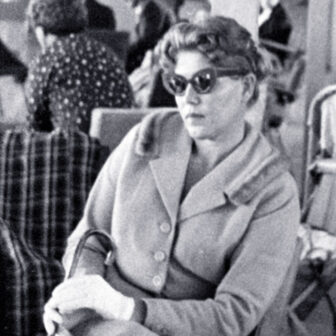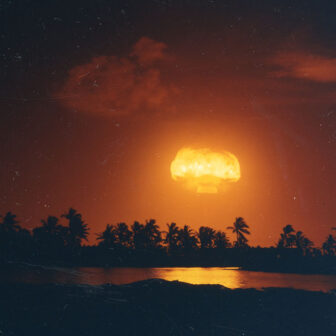ALTHOUGH the possibility of moving entire Pacific island communities often comes up in discussions about the impacts of climate change, it’s generally assumed to be a novel, even futuristic idea. But nearly seventy years ago, in quite different circumstances, two island communities were uprooted and transported to new homes elsewhere in the Pacific. In December 1945 the people of the island of Banaba (also known as Ocean Island) in present-day Kiribati were moved to Rabi Island in Fiji to make way for mining by the British Phosphate Commission, a joint British, Australian and New Zealand enterprise. Two years later, in October 1947, part of the population of Vaitupu, an island of present-day Tuvalu, bought and settled another Fijian island, Kioa, just kilometres from Rabi.
What was different about the two cases, and undoubtedly had an enormous impact on the subsequent development of the two communities, was the degree of choice involved. The Banabans say they had no choice about moving; the Vaitupuans made the decision themselves. When I talked to some of the original settlers still living on Rabi and Kioa, and to their descendants, their experiences offered important insights into the potential effects of any future efforts to resettle Pacific populations.
Pacific history is a story of mobility. For centuries, islanders have moved in response to changing environmental, political or social conditions. Even today, a remarkable number of people travel to urban centres for work or education, or journey around the world as seafarers on liners. During the colonial period, the government of the Gilbert and Ellice Islands Colony (which became Kiribati and Tuvalu in the late 1970s) responded to the scarcity of land and resources on these low-lying atolls with a policy of resettlement. Groups of islanders were sent to “colonise” parts of the Solomon Islands, for example, where they gradually integrated into the local community.
But the migrations to Rabi and Kioa are rare cases of whole communities moving to an empty island in another country to create a new home administered by their own local council. The motivations behind each of those relocations were radically different, though, and each is a fascinating counterpoint to the other.
SOON after the English prospector Albert Ellis discovered that Banaba Island was rich with A-grade phosphate in 1900, the British government annexed the island and mining began. Within a decade, the Pacific Phosphate Commission (later the British Phosphate Company) was agitating to have the islanders removed so that Banaba could be mined more efficiently and extensively. By the time mining operations ceased in 1979, twenty-one million tons of phosphate had been removed – thirteen million tons of it scattered across the farms of Australia. The Banabans received a 15 per cent share of the profit.
Almost all of the official records in these early years acknowledged the Banabans’ right to remain in their traditional homeland and benefit from the proceeds of any resources taken. But in the communication that was to secure their fate, the colonial administration noted that while it would be “repugnant” to “evict a native tribe” simply “to afford wider opportunity of gain to a rich commercial corporation,” in this case the greater good of the British Empire was at stake. “Indeed,” wrote Britain’s high commissioner for the Western Pacific, C.H. Rodwell, in 1919, “the interests of the Empire seem to demand that the process of development on Ocean Island should be allowed to continue until the whole island is worked out.”
Negotiations between the colonial authorities and the Banabans continued on and off for forty years, and it was only after the Japanese occupation of the island during the second world war that the islanders were finally removed. The Japanese had transferred the majority of the Banaban population to Tarawa, Kosrae and Nauru. At the end of the war, the colonial authorities told the Banabans that their homeland had been rendered uninhabitable by the Japanese and another island had been found for them in Fiji. According to the community’s founding myth, the Banaban elders were shown photographs of a town with two-storey houses and told that this was Rabi, their new home. It was not: it was Levuka, the former capital of Fiji. Believing that they were moving to an established and much better-equipped town, they agreed to go.
The majority of the population was sent to Rabi in December 1945. It was the middle of hurricane season, and some Banabans believe that they were never meant to make it. On arrival, they found no town and very few inhabitants – just some Solomon Islanders who had stayed behind to work on the coconut plantations belonging to the island’s previous owner. They had to live in tents beside the beach, with two months’ rations and little knowledge of how to plant the island and become self-sufficient.
The British records tell the story somewhat differently. They don’t mention deceptive photographs, but they do reveal that a decision was made to move the Banabans to Rabi “whether they were agreeable or not” because “there was no place in the Gilbert and Ellice Islands Colony where they could be adequately provided for.” Nevertheless, Major Donald Kennedy, who briefed and accompanied the group, reported that when he met with groups of Banabans before the move he opened each meeting by stating that “no person would be forced to go to Rabi against his will.” Kennedy reported to his superiors that only one person objected to moving, but even that sole dissenter eventually agreed to go.
The move was to be for a two-year trial period, and if the Banabans then chose to return to Banaba Island they were to be transported free of charge. The secretary of the Western Pacific High Commission thought it “very doubtful” that they would agree to remain on Rabi permanently, noting that their willingness to do so would “depend upon their treatment there and whether they get to like the place sufficiently during their enforced sojourn in the island.” This was a key factor in the decision to grant the Banabans a degree of autonomy in managing their affairs on Rabi, with “as nearly as possible the same Government organisation and powers of self-Government as they enjoyed and were used to in Ocean Island.”
Interestingly, the documents also show that Banaban elders had raised the subject of relocation as early as 1920. The first official approach about the possible purchase of an island for the gradual resettlement of the population was made by the Western Pacific High Commission to the government of Fiji in late 1924. The island would need “sufficient planting land for sustenance,” a water supply (if possible), and some anchorage for boats. Confidential inquiries were also made within the Gilbert Islands. But when a new high commissioner was appointed in 1925, he was not in favour of resettlement within Fiji even if an island were available.
“I am of the opinion that they would never settle down contentedly under the new conditions of life in Fiji,” he wrote. “Native customs and traditions vary very materially in the various groups of islands in the Pacific, however adjacent they may be to each other…” Then there was the question of how the community would be administered. “It would not be correct to require them to conform to Native Regulations en bloc or to the system of taxation applicable to natives. They would certainly resent the imposition of taxes in a form to which they have been unaccustomed to meet in Ocean Island, and it would seem to be inequitable to make them subject to taxation borne by Europeans and persons in Fiji other than natives.”
The Banabans started to agitate again for a “new home, Banaba No. 2” in 1940. They stressed that it was not a replacement for Banaba Island, but rather a second home, and that their land rights on Banaba should not be diminished. One of their main concerns was that “the younger generation of Banabans was growing up in too Europeanised an atmosphere and that, if they were to preserve their racial identity and culture, it was necessary to continue that culture elsewhere.” For this reason, they desired a new home where they could “resume native cultivation, mat-making and fishing.” The Western Pacific High Commission purchased Rabi on the Banabans’ behalf in 1942.
Yet the degree to which the Banabans gave informed consent to their ultimate move to Rabi is unclear. In some respects it has become irrelevant: the founding myth of Rabi, built on a narrative of deceit and injustice, has potency to this day. At its heart lies a complex story about loss of homeland, deprivation of resources and the destruction of identity. The three are intertwined: while people feel a visceral and spiritual connection to their original island, Banaba Island – even though most have never been there – the loss of home is not just about loss of place and personality.
At its heart, it is about the loss of self-determination. “Home” is not just an emotional or esoteric construct, but also incorporates land, rights, sovereignty and power – the power to shape one’s destiny. At first I was taken aback when one old lady, who was born on Banaba and moved to Rabi when she was in her early twenties, explained that she wouldn’t mind if Banaba were mined again today, provided that the Banabans profited from it. Given the visceral connection to “land,” I had assumed that this meant only preserving and rehabilitating it. But then I realised that a large part of the injustice felt by the Banabans is a loss of control over their own territory and resources.
When Kiribati became independent in 1979, the colonial authorities determined that it would retain Banaba Island as part of its territory. Although Kiribati’s constitution gives the Banabans a special status, with guaranteed parliamentary representation, an “inalienable right to enter and reside in Banaba,” and a veto over any constitutional amendments relating to their interests, most Banabans don’t regard themselves as I-Kiribati and view the relationship with Kiribati uneasily. Many say that they should be independent, and from time to time they have agitated to have Banaba Island recognised as an independent state. In a submission to the British government in the 1960s, the Banabans argued that they should be granted independence under the UN Declaration on the Granting of Independence to Colonial Countries and Peoples. Their island, they argued, was “a separate geographical entity” annexed to the Gilbert and Ellice Islands Colony “only because of the phosphate.”
Most of those in authority today regard any move for secession as futile, but a number of Banabans still want it – mainly because Kiribati has received 85 per cent of the phosphate royalties and the Banabans only 15 per cent. Some regard the government of Kiribati as just another pawn in a British scheme; others resent Kiribati itself and are inherently suspicious of any action it proposes in relation to Banaba Island, including its rehabilitation.
THE story of Kioa is very different. Not only did the Kioans choose to leave Vaitupu, but only a part of the community made the journey. Indeed, the fact that today they refer to themselves as Kioans (after their “new” home) reveals something interesting about their move to Fiji.
During the second world war, some of the men of Vaitupu in Tuvalu had assisted the American military in the Pacific. At the end of the war, they decided to pool their war savings to invest – probably in a school or something similar – for the benefit of the Vaitupuan community as a whole. But Donald Kennedy, a New Zealander who had been a school teacher on Vaitupu, suggested that they purchase Kioa in Fiji as an insurance policy against overpopulation and land scarcity. These were real concerns throughout much of the Gilbert and Ellice Islands Colony, but in fact Vaitupu had the lowest population density of the Ellice group, so it was a curious proposal. Nevertheless, the community decided that it would use its funds to buy freehold title to the island, and having made the purchase in June 1946 it called for volunteers to settle there.
I had the good fortune to be in Kioa on Kioa Day, which commemorates the arrival of the first settlers from Tuvalu in October 1947. (Interestingly, its counterpart on Rabi is Banaba Day.) I also had the privilege of speaking to eighty-eight-year-old Siapo Paka, the sole remaining survivor from the original group of settlers. At first, she told me, no one had wanted to make the move from Vaitupu. Eventually, thirty-five people volunteered to journey to an island they knew was empty, save for an old wooden house that the island’s previous European owner had constructed. They arrived there on the afternoon of 26 October 1947, Siapo Paka recounted, and half of the group was instructed to trek to the other side of the island at twilight, following the tracks of wild pigs through very dense bushland. In the first years of settlement, they had to clear the land, construct houses one by one for each family group, and plant crops.
The Kioans see their story as one of community survival. On Kioa Day, the floral wreaths that people wear on their heads represent unity – no matter how many different flowers are bound together, they are ultimately one, just like the people of Kioa. The people say that they have two homes – Kioa, the homeland, and Vaitupu, the motherland. Many people identify as Fijian and Vaitupuan, although, interestingly, Siapo Paka describes herself as Fijian. Many still have land and relatives back on Vaitupu and have visited several times. The council helps to arrange annual visits to Vaitupu for the young people. Since Vaitupu continues to sustain a large community, there is perhaps more openness among the Kioans towards adopting two identities.
While the Banabans also say they have two homes, the relationship to Banaba Island is still fraught. They don’t see themselves as I-Kiribati and yet, despite being Fijian citizens, most of them don’t regard themselves as Fijian either. Banabans feel an affinity with Fiji, however, and a sense of gratitude for its hospitality in accommodating them on Rabi. A common refrain among those interviewed was, “I am Banaban. I am only Fijian because of my passport and because I live in Fiji.” In his submission to the Fiji Constitutional Commission, the former Rabi representative in the parliament of Kiribati, David Christopher (who was later an MP in the Fijian government), put it this way:
The word Fijian is associated with race, with the race of the indigenous community of Fiji. Banaba is an island in the central Pacific Ocean. The indigenous community on Banaba are called the Banabans. I am a descendant of the indigenous community on Banaba and I call myself a Banaban. I find it difficult and most uncomfortable to call myself a Fijian as I was not a Fijian and will never be a Fijian.
TODAY, on both Kioa and Rabi, descendants of the relocated islanders acknowledge that their new Fijian homes provide abundant food and water, sustaining far larger populations than their home islands ever could, and give young people access to greater educational and economic opportunities. On the other hand, intermarriage, which is far easier amid the islands of multicultural Fiji, is seen as a threat to traditional culture. Interestingly, the people I spoke to saw tourism as a positive influence. In Kioa, for example, traditional dances are performed weekly for tourists visiting on large adventure yachts, and a councillor explained that this helps to keep the culture alive.
When people have been uprooted from their homes – especially under coercion – there is a tendency for the natural evolution of a culture to come to a halt. The culture at the moment of migration becomes the “authentic” culture, frozen in time, and subsequent transformations are measured against that standard. When I asked people on Rabi whether they felt that their culture had changed since the relocation, almost everyone referred to a much earlier event – the decline of the Banaban language in the nineteenth century following the arrival of missionaries who adopted Gilbertese, the language of Kiribati, in their dealings with local people. Even though this was long before the relocation in 1945, the destruction of culture was inextricably linked to the arrival of the British. Timeframes were thus collapsed into a single narrative.
Even though everyone I interviewed recognised that life was better in Fiji, the Banaban story is still marked by a history of injustice. One interviewee described a “psyche of injustice” that has been “burned into our memories.” A number of people talked about the difficulties of changing this mindset, viewing it as hampering the community’s ability to move forward.
Banaba Day is the primary official way that the story of the relocation is passed down to the younger generations. Some of the people I interviewed suggested that the day has become a ritual that lacks real meaning for those who have never been to Banaba Island – people for whom the relocation is a historical event, rather than part of their lived experience. It may be that the poignancy of the Banaban story fades with time – indeed, many older people expressed fears that it has already started to disappear. Interviews with younger people revealed a patchy and at times flawed knowledge of the relocation and of current governance and citizenship arrangements. What was interesting, though, was the way they stressed the importance of Banaban culture and their belief that they were maintaining its traditions. All invoked the wrongs done to their ancestors.
It is not difficult to imagine how a similar story of injustice could develop now if the inhabitants of small island states are resettled elsewhere without extensive prior consultation, negotiation and compensation. Climate change will exacerbate existing vulnerabilities in small island states, and it will be a reason why certain places become unfit for human habitation. Climate change alone will not cause displacement from countries like Kiribati and Tuvalu – it will act as a tipping point, interacting with overcrowding, environmental fragility, poor development practices and resource scarcity. Pacific island countries have been lobbying their neighbours for decades for enhanced migration opportunities, given the scarcity of resources and jobs at home.
This history and the complex causality of displacement – climate change interacting with other factors – could well be lost if groups feel forced to relocate. If group relocations become a serious option, then the rights of those affected (both in the sending and receiving countries) must be protected, and the legal status and organisational structures of the relocated group in the new country must be planned meticulously.
Above all, we need to have a clear answer to the question: which trajectory will we take, a Rabi or a Kioa? •




